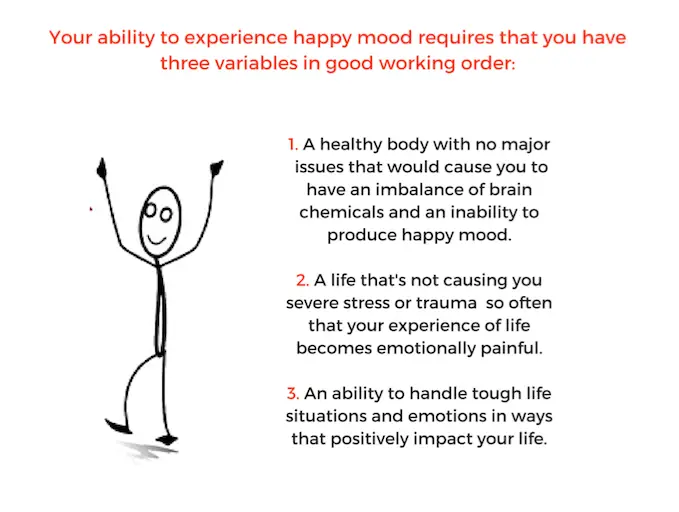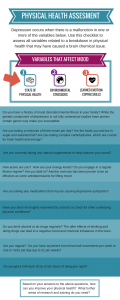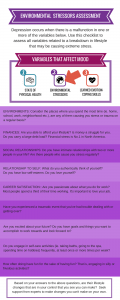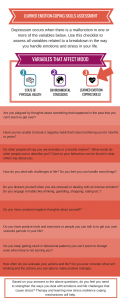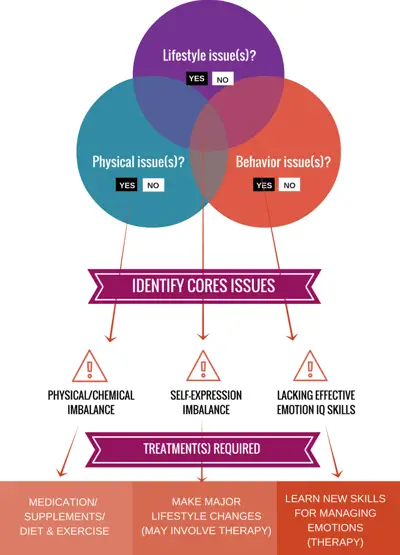How to help your teen conquer their depression
…and get your happy child back
The only way you can help your teen out of depression is to understand what they are going through. Helping is impossible if you don’t know the full story of what they are dealing with what’s likely causing their depression. Knowledge is key and it’s the first step.
You need to learn about depression, but also, teen depression specifically. It’s a bit different.
In short, here’s the biggest difference between a teen who is suffering and an adult: Most teens are dealing with challenges they are having difficulty overcoming and managing that are causing them extreme stress, AND/OR they have not learned healthy stress-coping skills.
Which is good news because it also means that most teens are too young and have too little life experience to be at point where they have developed a serious neurological issue. (It says “most” because it’s possible that some people are born with gene or brain defect that may make them more vulnerable to depression even in childhood. Science has gained evidence but nothing has been concluded with regards to genetic links or brain differences in depressed people)
If you think back to when you were a teen you will likely be able relate to your teens struggles. The transition between childhood and adulthood is challenging for most people. During the teenager years, we all have to learn how to be responsible. Life becomes much more complex. It can be confusing for many.
In terms of depression at this stage of life there are some positives. Because your teen likely just needs help learning how to deal life challenges, and in some cases, simply needs some direction on actions to take to minimize stress so they can feel better.
However, the negative aspect of depression with teens comes down to how little they learn to communicate and “vent” about what they are going through. And when they don’t communicate because they don’t feel comfortable, they harbor pain and it can lead to dealing with tough emotions in unhealthy ways.
This can lead to accidents, which is how most teens end their lives. They suffer in silence and when the pain is too much they look for a way out.
So, the second step in the process of helping a teen overcome depression is for parents to strengthen their own communication skills so that they can be someone their teen feels comfortable confiding in, or that they can help their teen find someone they can talk to if there are certain subjects they aren’t ready to discuss.
Dealing with depressed teen stressful, especially when you can’t seem to get through to them. You may feel stuck but to recap here are the steps you need to take to prevent depression and suicide:
- Educate yourself about depression and teen depression. Start by continuing to read this page. Download the Depression Recovery Map and watch the mini course about it.
- Strengthen your communication with your teen. Depending on where it is now you may need to resolve upsets and learn new skills yourself. There are videos, articles and course available on this site.
- If your teen is in crisis they need to see a medical professional immediately. Any teen with depressive symptoms that last for more than two weeks needs to be taken to a doctor for diagnosis in conjunction with support from a parent.
You can start here, with step one, learn about depression specifically first before you do anything else. The map and video below will help you get a sense of what your teen is struggling with.
Here’s an explanation of the map, the pdf is available below.
The Map
Your body is a very complex machine. It’s parts aren’t made of metal. They are naturally derived. But that doesn’t mean your body is not similar to that of, say, a car. Both are systems of interrelated parts that depend on each other to function as a whole.
When you lose function in some parts of a car, the entire vehicle shuts down. Yet, when a car loses function in other parts, the machine can compensate.
So it is with your body. Your heart stops, you’re dead. But if you get the flu, you don’t go to work, but you rest.
And then of course there is wear and tear from your environment. A car goes through it, and so do you. Too much stress overtime, leads to malfunction and breakdown.
Depression becomes much more simply to understand when you look at it as a disorder that occurs when a system gets out of balance and malfunctions. There are many ways that can happen but it can all be consolidated to a malfunction in one or more of three variables. That’s what you learn from this map.
This map works for anyone who wants to conquer their depression. It works for teens who are facing their first battles with roller coaster moods. It works for you regardless of your experience with depression. Long time sufferer. Chronically depressed. Life challenged depressed person. And the famous: “I don’t know why I am depressed and no one can tell me why.”
This map works because it exploits each and every aspect of the irrefutable law of recovery:
There are only three ways to defeat depression.
- Repair any issues that causing a brain chemical imbalance.
- Repair any areas of life where you are struggling and under extreme stress.
- Repair any negative behavioral patterns that don’t serve you.
This is the basis for the Depression Recovery Map.
Read this page carefully. Read it multiple times and commit it to memory.
This is a general map that applies to anyone with depression, including teens. Keep in mind that variables 2 and 3 of the map are more commonly the issues out of sync in teens.
Learn the Steps to Depression Recovery
The following free Depression Recovery Map outlines the method to conquer your depression.
Print this PDF version and tack it to the wall next to your bathroom mirror. If you plan to execute this map, you’ll need to look at it often.
When you’re learning new depression fighting tactics you’ll need to constantly remind yourself of the DRM process. Otherwise, you’re wasting time and, really, wasting your life.
This is a warning: There is little advantage in understanding, for example, antidepressants or cognitive therapy in and of itself. There is enormous value in understanding how to apply these tools to your depression recovery process.
Here is a flowchart of the Depression Recovery Map system…

Step 1 – Know the three causes of depression
There are many definitions out there on the web and in books that describe depression as: “A complex disorder with a combination of biological, social, environmental aspects”.
Common, now. That’s a bit vague.
That means that the only way a person can get depression is if one, two, or all three of these variables that make a healthy person, malfunction. Those variables are:
- Your state of physical health
- The way your environment affects your stress levels
- The way you cope with stress and life, in general
If you have a major issue in one of or more of these three areas you will likely get depression.
And, it will likely get worse if you do nothing to get it whatever is not working back in working order. So it’s crucial you evaluate all three of these aspects of you’re life to understand what possible weaknesses could lead to breakdown.
Step 2 – Assess all the ways any of the three variables can go from normal functioning to breakdown
Depression is a complex illness because there are many ways each one of the three variables can go from healthy and in working order to malfunction.
The key to reversing, solving and managing depression is to identify what’s caused the malfunction by taking an inventory of all the variables that lead to a health crisis.
It’s one thing to understand you have a physical brain chemical issue, but what’s most important and overlooked is what caused the it in the first place. Is a lack of nutrition? Could it be a lack of sleep in your routine? Perhaps, you have an underlying medical issue you didn’t know about.
It’s important to look at the sources of breakdown because they will dictate your course of effective treatment to get you feeling better fast and allow you to eradicate that issue altogether and save you issue in future.
If you live anywhere in North America, we live in nation that takes treatment-first approach to health.
The problem is when you treat the symptoms for depression and don’t get to what caused it those behaviors continue and often the person gets sick again.
That’s why the depression map has three pages of questions that allow you delve deeper and ask yourself a series of questions to get a better understanding of issues you may not have considered:
It’s important you do this work. It may shock you to know that 90% of people diagnosed with depression are incorrectly diagnosed and do not need medication. Many can make changes to their lifestyle or learn new behavior skills and will start to feel better very quickly.
Sure, you could jump into some type of treatment without doing the work to understand what the real problem is. Sometimes that works. But sometimes there a major negative impacts. And when anything is negative with regards to your health, it’s not worth it.
So take a little time before treatment to try and understand what’s wrong. You likely get some insights on ways to act.
Step 3 – Identify core issues so you know what actions to take with regards to treatment
When you know what’s caused the malfunction it will open up new actions you can take to get to feeling better and restoring your health. And, taking actions after doing some discovery work will increase your ability to make smart choices that will lead to effective and speedy recovery.
Learning what you need to do to get better and put in place to prevent future depression can take some time but when you learn skills like – how to eat well and still indulge, how to incorporate daily fitness, how to communicate during tough situations – you’ll be more mentally fit than most people.
The video that accompanies the Depression Recovery Map discusses the three treatment options all people with depression should consider.
The entire map and recovery are designed to get you “unstuck”, and to reveal to you the actions you need to take now to get better as quick as possible.
Wherever you are in your journey with depression, the Depression Recovery Map is a great place to start. If you’ve been struggling for a long time you may learn something new that will completely alter your approach. If you’re experiencing symptoms for the first time it will direct on what to do about it.
Download your free Depression Recovery Map and watch the accompanying video for free.
